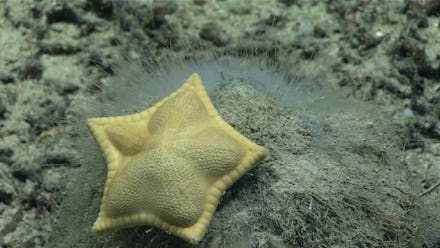There's a starfish that looks like it's made by Chef Boyardee

Are you ready, readers? What looks like ravioli under the sea? Plinthaster dentatus! The "ravioli" or "cookie" starfish isn't something you'd see in SpongeBob SquarePants. It's very real, and very rare. And yes, like its nickname implies, it really does look like ravioli, stuffed to the brim with beef. Or a puffy cookie that you can't wait to bite into. It may very well be the tastiest-looking starfish in all the waters of the world, and that's part of what makes it so fascinating.
Though it was first discovered all the way back in 1884 and has been seen several times throughout history, scientists haven't been able to come up with much information about the peculiar species – that is, until recently.
During a recent expedition by the NOAA Ocean Exploration and Research Team in the waters off the southeastern coast of the United States, researchers were able to spend some time with and observe the animal for a short time, as well as document some of its regular, everyday activities. This was facilitated while researchers were aboard NOAA's Okeanos vessel, which is the "only federal vessel dedicated to exploring our largely unknown ocean for the purpose of discovery and the advancement of knowledge about the deep ocean."
Thanks to some of the instruments and advanced technologies aboard the Okeanos, they were able to take plenty of images and video of it during a few "feeding frenzy" events. The NOAA team, in fact, was privy to one of these strange sessions where the ravioli starfish and a large cidaroid sea urchin were seen chowing down on a deep sea "glass sponge."
"At least six individuals were involved," wrote the National Museum of Natural History's Chris May, of the event. "This prompts many questions! Is it by chance that they are all in the same place? Is this sponge damaged and the sea urchins taking advantage? Is this a common occurrence?" These are all questions that scientists just can't answer yet, seeing as they've had such limited interactions with or viewing the starfish in the past.
Now that scientists have had the chance to look into this strange creature's normal habits, perhaps there will be additional opportunities in the future to perform more research so we can learn more about it in general. It's not every day you find an undersea creature that resembles a delicious star-shaped Italian pasta, after all.
But this is hardly the weirdest thing out there below the sea. According to the NOAA, more than 80% of the world's oceans are "unmapped, unobserved, and unexplored." There's really no telling what kind of creatures await us out there. NOAA itself is leading efforts to change this, and its latest expedition was just part of the initiative to turn the tide, so to speak.
Perhaps someday, somehow, we'll be able to document them all. Until then, it's perfectly fine to wonder about whether or not there happens to be any more food-like creatures in the deep, dark ocean that look as unassuming (and appetizing) as this one.